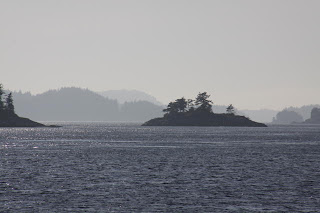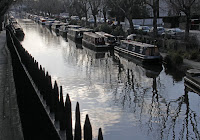 Piers jut into the bay. Fishing boats, many in disrepair, bob in the water. Totem poles reach toward the sky. The tang of salt and seaweed hangs in the air. Alert Bay on Cormorant Island off the northeast coast of Vancouver Island is one of the most exotic towns in Canada.
Piers jut into the bay. Fishing boats, many in disrepair, bob in the water. Totem poles reach toward the sky. The tang of salt and seaweed hangs in the air. Alert Bay on Cormorant Island off the northeast coast of Vancouver Island is one of the most exotic towns in Canada.My dearest, Ally, and I and eight other guests are aboard the Columbia III on a Mothership Adventures’ tour that is meandering through the Broughton Archipelago and focusing on First Nations culture.
 We visit the U'mista Cultural Centre, which captures both the agony and glory of the Kwakwaka'wakw people. A film shows how the white man in the late 1800s banned the potlatch, an important Native ceremony. In 1921, a large “illegal” potlatch on Village Island was raided and the priceless ceremonial regalia confiscated. Some of the seized items were repatriated and are now displayed in the Potlatch Collection of the Centre. The gallery, designed as a big house, is full of colourful masks representing ravens, eagles, orcas, bears, the moon and sun as well as supernatural creatures. I sense a powerful pulse, an emotional celebration of the songs, legends and dances embodied in these masks.
We visit the U'mista Cultural Centre, which captures both the agony and glory of the Kwakwaka'wakw people. A film shows how the white man in the late 1800s banned the potlatch, an important Native ceremony. In 1921, a large “illegal” potlatch on Village Island was raided and the priceless ceremonial regalia confiscated. Some of the seized items were repatriated and are now displayed in the Potlatch Collection of the Centre. The gallery, designed as a big house, is full of colourful masks representing ravens, eagles, orcas, bears, the moon and sun as well as supernatural creatures. I sense a powerful pulse, an emotional celebration of the songs, legends and dances embodied in these masks.Next door sits the abandoned, decaying St. Michael=s residential school, a hulking, red-bricked reminder of the persecution of the Native people.
Then we visit the Big House whe
 re a large fire lights the dusky interior, showing colourful totems and immense cedar posts and beams. Amidst the smell of smoke and cedar four men drum on a log. The “Determined” dancers, mostly youngsters, circle the flaming fire, proudly performing traditional dances in native regalia.
re a large fire lights the dusky interior, showing colourful totems and immense cedar posts and beams. Amidst the smell of smoke and cedar four men drum on a log. The “Determined” dancers, mostly youngsters, circle the flaming fire, proudly performing traditional dances in native regalia.I am touched by the cemetery in the middle of downtown with its extraordinary array of totems as well as crosses, a strange mixture of Native and non-Native faiths.
Boarding the Columbia I don’t know whether to rejoice or to cry. The soul of the First Nations people is laid bare in this town of contrasts. In places it has poverty and living conditions that makes it feel like a third-world country. But it also displays a culture that is powerful, rich, appealing and rooted in nature. This contrast screams out about the injustices that native people have suffered and the difficulties they continue to face.
 We motor on. Once the rising sun chases the fog, the Columbia purrs through the archipelago leaving a wake that gently caresses the shorelines. A mortuary box peers out of the greenery on one island. On another, vertical scars on cedar trees mark where Natives “farmed” bark. At Village Island a decaying totem pole lies in the forest. Along the shore of another isle, rocks are piled along the tide line so clams could be harvested. Later, a petroglyph winks at us from a cliff.
We motor on. Once the rising sun chases the fog, the Columbia purrs through the archipelago leaving a wake that gently caresses the shorelines. A mortuary box peers out of the greenery on one island. On another, vertical scars on cedar trees mark where Natives “farmed” bark. At Village Island a decaying totem pole lies in the forest. Along the shore of another isle, rocks are piled along the tide line so clams could be harvested. Later, a petroglyph winks at us from a cliff. One day, the captain catches up with the A12 pod of killer whales (aka orcas). High black dorsal fins slice effortlessly through the water and spouts of spray rise in the air.
At the Burdwood Group, a glorious gaggle of little islands, we lower kayaks into the water. Some of us paddle while others go ashore to explore the middens (layers of broken clam shells left by centuries of First Nations habitation) and enjoy the view while sitting on sun-warmed rocks.
Group, a glorious gaggle of little islands, we lower kayaks into the water. Some of us paddle while others go ashore to explore the middens (layers of broken clam shells left by centuries of First Nations habitation) and enjoy the view while sitting on sun-warmed rocks.
 Group, a glorious gaggle of little islands, we lower kayaks into the water. Some of us paddle while others go ashore to explore the middens (layers of broken clam shells left by centuries of First Nations habitation) and enjoy the view while sitting on sun-warmed rocks.
Group, a glorious gaggle of little islands, we lower kayaks into the water. Some of us paddle while others go ashore to explore the middens (layers of broken clam shells left by centuries of First Nations habitation) and enjoy the view while sitting on sun-warmed rocks. All too soon it is time to go aboard and chat about today’s adventures over a glass of wine and a gourmet meal. Dusk settles and the islands transform into soft velvety shapes.
More Info
• www.mothershipadventures.com
• U’mista Cultural Center: www.umista.ca
• www.aboriginalbc.com
• I’ve prepared a 32-page, glossy, full-colour book that is rich with photos using Blurb publishing technology. It looks great and contains a lot of information about First Nations and the Broughton Archipelago! Order it through Blurb at:




























